Content

Growing white cabbage in the open field
The need for growth
Cabbage should not be grown in shaded areas. Cabbage requires a lot of light, this plant is a long day, i.e. with a long day, her developmental processes go faster. Lack of light leads, as already mentioned, to the accumulation of nitrates, disruption of plant development. Lacking light, the lower leaves stop growing, begin to turn yellow and die off early. The apical bud continues to grow and throws out more and more new leaves, but does not tie a head of cabbage.
Cabbage is a cold-resistant plant. The plant can tolerate a short-term drop in temperature to -5 ° C, and even lower in autumn. Cool weather with a temperature of 15-18 ° C is most favorable for cabbage growth. Temperatures above 25 ° C have a negative effect on the formation of heads of cabbage. In hot dry weather, an increased accumulation of nitrates begins.
Cabbage is very demanding on moisture, but excessive moisture is harmful for it. With excessive moisture, the roots begin to die off, and the leaves acquire a crimson color and then die off and a dangerous disease develops - bacteriosis. In plants affected by bacteriosis, a huge number of black spores can be seen in the tissues on longitudinal and cross sections of the stumps.
Cabbage is placed after well-fertilized crops. Early varieties are well placed after onions, cucumbers, tomatoes. Late varieties can be placed after potatoes, root crops, legumes. In one and the same place, it should not be grown more often than once every 3-4 years in order to avoid diseases. It is good to grow celery, thyme, sage, coriander and anise next to cabbage plants to keep the cabbage fly away.
How to prepare the soil for growing cabbage
Cabbage is high in nitrogen, potassium and calcium. High doses of organic fertilizers (manure or compost) are used for cabbage. But the introduction of the maximum dose of nitrogen contributes to a deterioration in the quality of products - more nitrates, less sugars and dry matter.
The best effect is obtained by combining organic fertilizers (30-60 kg per 10 sq. M.) With mineral fertilizers. Early varieties of cabbage in the middle lane ripen in July, when increased decomposition and mineralization of manure begins. Therefore, in order to avoid the accumulation of nitrates under early ripening varieties of cabbage, only greenhouse humus or compost should be applied. On mid-ripening and late-ripening varieties of cabbage, peat-fecal composts, peat fertilizers, and finally, peat with phosphorites have a good effect. Fresh manure can be applied only for late and mid-late varieties and only in autumn, scattering it over the soil surface. At the same time, it should not be allowed that the manure is mixed with lime, which is also introduced in the fall.
The best fertilizer ratio for cabbage: 30-60 kg of organic fertilizers plus 90-120 g of mineral nitrogen, 90 g of phosphorus and 60 g of potassium.
In spring plowing, all the phosphorus, 2/3 of the potassium and half of the nitrogen are added. The rest of the fertilizer - when closing the rows and curling the heads of cabbage.
When digging, 1-2 g of boric fertilizers are applied per 1 sq. m.
Of the trace elements for cabbage, the most important are manganese, boron and copper. Adding them in top dressing (preferably foliar) increases the yield of early cabbage by 20-30%, late - by 10%.
The optimum pH value of the salt extract of the soil for white cabbage is 6.6-7.4.
On soddy-podzolic soils, liming of the soil is necessary, it prevents many cabbage diseases and contributes to the correct absorption of fertilizer nitrogen. The amount of lime introduced into the soil depends on the quality of the soil, its physical and chemical composition and the degree of acidity. On average, on weakly acidic soils, from 1 kg (on sandy soils) to 4 kg (on clayey) lime is applied, on highly acidic soils, respectively, from 2 to 10 kg per 10 sq. m. Lime or chalk is introduced in the fall, scattering them over the surface of the dug soil. It is desirable that the applied lime does not come into contact with the manure. Adding lime not only changes the acidity of the soil, but also improves its structure. Cabbage tolerates excess calcium well.
With optimal soil acidity, the number of bacteria increases significantly, the number of fungi decreases and the development of pathogenic microorganisms, as a rule, does not acquire a dangerous size.
At home, it is worth growing seedlings only if it is possible to create optimal conditions for its growth and development. Unfavorable growth conditions, especially a lack of light during the seedling period, can adversely affect the growth and development of plants in the future. Therefore, if there is no confidence in the successful cultivation of seedlings, it is better to purchase it from reliable suppliers.
Growing cabbage seedlings
Cabbage is grown as seedlings to speed up maturation. Seedlings of the same age grown on different calendar dates differ sharply. Improvement in temperature and light conditions accelerates growth rates, and with earlier sowing, seedlings may develop more slowly if growing conditions are worse. Therefore, when calculating the sowing time for cabbage seedlings, one must bear in mind the possibility of creating optimal conditions for its development.
For the earliest possible harvest, early varieties of white cabbage can be sown in a greenhouse or room (with additional lighting) from February 25 to March 5; later they can be planted in mid-April under a temporary shelter (under the film). If good growth conditions are created for the seedlings, then the harvest can be obtained as early as May. For cultivation in open ground without shelter, early varieties of white cabbage can be sown on March 10-15, with planting in a permanent place in late April - early May.
Seedlings of mid-ripening and late-ripening varieties can be grown in a greenhouse with solar heating or a nursery under the film, prepared for the earliest possible sowing. Sowing of late varieties is carried out from 1 to 10 April, mid-season - from 10 to 20 April.
Before sowing, the seeds are pickled in a solution of potassium permanganate or disinfected with hot water at a temperature of about 45-50 ° C for 20-30 minutes, followed by rapid cooling in cold water. To increase productivity and resistance to diseases and pests, seeds are treated with a biological growth and development activator - Agat-25, El-1, Albit, Zircon before sowing.
The best way to get healthy seedlings is to grow in cassettes (pots) with a volume of 65 cm3 (4.5 x 4.5 x 3 cm). Seedlings grown in cassettes tolerate transplanting more easily, are a little sick.
Seeds are sown to a depth of 0.5-1 cm, crops are watered immediately. For growing cabbage seedlings, the temperature is maintained at 15-18 ° C during the day and 8-10 ° C at night.
To increase growth, anti-stress activity, as well as disease resistance, 10 days after sowing and 5 days before planting seedlings in a permanent place, the soil is treated with 0.015% sodium humate solution.
Seedlings are fed twice: in the phase of two or three true leaves and 3-5 days before planting in the ground.For top dressing, 15 g of urea, 30 g of superphosphate and 30 g of potassium chloride are diluted in 10 liters of water. For one plant, use 0.15 liters in the first feeding and 0.5 liters in the second. Spraying cabbage in phase b-8 leaves with Silk leads to an increase in yield, an increase in the content of sugars and vitamin C.
7-10 days before planting seedlings in open ground, they are hardened, ie. withstand in more severe conditions: increase ventilation, reduce temperature, reduce watering.
By the time of planting, the seedlings should be hardened, 18-20 cm high, with 4-5 well-developed leaves (this is 35-45 days old).
If the growing regime is violated (poor ventilation, thickening of plants, strong temperature drops and waterlogging of the soil), peronosporosis (downy mildew) may appear. It manifests itself on the cotyledons and leaves of seedlings in the form of gray-yellow oily spots, covered with a mealy bloom on the underside of the plate. To combat peronosporosis, cabbage is pollinated with wood ash (50 g per 1 sq. M) at intervals of 5-7 days. But first of all, it is necessary to provide optimal conditions for keeping plants.
Cabbage seedlings are often affected by the black leg. The infection persists and accumulates in the soil, develops with excessive air humidity, sharp fluctuations in soil temperature and thickened planting, and lack of ventilation. When symptoms of a black leg appear (the root collar and stem turn black, thin out), the plants should be watered with a 0.05% solution of potassium permanganate (5 g per 10 l of water - raspberry color). Calcined sand is added to the treated plants in a layer of up to 2 cm. Resistant (relatively) to the black leg of the varieties Belorusskaya 385, Moskovskaya pozdnaya 15, Amager, Gift 2500, Kubanochka, Nadezhda, Malachite Fi.
To combat an earthen flea, it is necessary to pollinate seedlings with tobacco dust.
Planting cabbage seedlings
In low swampy places, cabbage should be planted on ridges 100 cm wide and 18-25 cm high. In areas where there is no danger of waterlogging, cabbage is grown on a flat surface. Growing in narrow beds has a positive effect on the quantity and quality of the crop.
Cabbage needs to be given a very bright spot. Even a slight shading will lead to a slowdown in development and a decrease in quality - a drop in the content of vitamins, the accumulation of nitrates.
Landing dates
Cabbage is a cold-resistant plant, it can tolerate temperature drops of up to 5 ° C, but only for a very short time. Therefore, you can start planting cabbage seedlings in a permanent place from mid-April under a film with a cover from frost with a non-woven covering material. Covering plantings with non-woven material raises the temperature by 1.2-5.1 ° C, accelerates the production of ecologically valuable products by 7-10 days, and increases the yield by 2.3-5.4 times. At the same time, there is no stretching of seedlings, since the non-woven material allows air to pass through more easily. The cover with non-woven material and especially with a film must be removed in a timely manner, on May days there should be no overheating, which leads to stretching of the seedlings, curvature of the stems.
In a field without shelter, seedlings of early and late-ripening cabbage in the middle lane begin to be planted in the second half of April (depending on the position of the site and on the weather) and finish between May 5 and 20. Mid-season varieties can be planted at the same time, but if there is not enough time, then medium-sized seedlings can be planted later.
With a decrease in the area of nutrition of cabbage, growth slows down, the amount of vitamins in the heads of cabbage decreases. Saving space can result in lower quality products and a decrease in yield.
Early cabbage succeeds better if grown in narrow beds of 1-2 rows at a distance of 70 cm between rows and 30-35 cm in a row. For mid-ripening varieties, the distance between rows is 70-80 cm and in a row 50-70 cm (depending on the size of the head), for late-ripening varieties the distance between rows is at least 70 cm, in a row 80-90 cm.It is not worth reducing the distance - the resulting heads of cabbage will be poorly stored, the possibility of disease will increase.
Planting schemes for cabbage
So that the area in the first month is used more rationally, you can plant early green vegetables between the plants, which will be removed within one month.
The sequence of actions when planting cabbage
Afternoon is the best time to board. The site must be watered the day before planting.
1. Water the seedlings 2-3 hours before planting to minimize root damage. To stimulate root formation, you can pour it not with water, but with a solution of heteroauxin (2 tablets per 10 liters of water).
2. The root system of the seedlings taken out of the pot (cassette) is dipped into a mash made of clay with the addition of 0.3-0.4% phytolavin-300 solution to protect against blackleg and bacteriosis.
3. Add chalk and a handful of humus to the wells for planting, water the wells with a suspension of the biological product nemabakt to combat cabbage fly.
4. Each plant is planted in a hole up to the cotyledon leaves, tightly squeezing the roots with soil. It is necessary to be especially careful to protect the heart (apical kidney), in no case to sprinkle it with earth. It is necessary to ensure that the roots do not bend and do not become clumped, but are distributed more or less evenly so that the seedlings are well compressed by the earth (after planting, the seedlings should not be removed with a slight twitch).
5. Pour 0.5-1 l of water under each plant. When watering, the watering can should be kept as low as possible to the ground, since the trickles of water falling from a height destroy the soil lumps, after which a crust forms.
6. An hour or two after watering the soil surface is covered with dry earth. The last operation is important, it can be equated with watering.
7. To scare away cabbage flies, the next day after cabbage planting, the soil around the plants within a radius of 4-5 cm is sprinkled with tobacco dust or its mixture with fresh lime or ash (1: 1). For 1 sq. m consume 20 g of such a mixture.
Seedless growing method
Cabbage is frost-resistant, early and middle varieties can be sown directly into the soil 3-6 weeks before the last frost. Seedless cultivation has the advantage that the plants grow in one place all the time and the root system is not damaged. This method is used to grow mainly early and mid-season varieties.
Sowing is carried out in well-dug soil, sowing 3-4 seeds into the nest at the same distance as when planting seedlings. Then the seeds are carefully covered with earth or a mixture of peat and humus. When growing white cabbage, it is advisable to use a non-perforated film, removing it no later than the appearance of the 2nd true leaf. The microclimate promotes a more rapid passage of developmental stages in which plants are susceptible to disease. Further cultivation under the film leads to stretching of the seedlings, curvature of the stems.
When the second and third true leaves appear, thinning is carried out, leaving at first two in the nest, and when thinning again, one plant at a time.
Plant care
There are three periods of cabbage growth: the first from the moment of planting to the beginning of the full growth of the foliage, the second - until the foliage closes, and the third - from the closure of the foliage to harvesting.
White cabbage is sprayed 3 times with a solution of gibbersib in the phase of 6-8 leaves, at the beginning of the formation of the head of cabbage and 7 days after the second spraying.
Gibbersib increases the yield by 12-20%, increases the content of sugars and vitamin C.
The cabbage is sprayed with immunocytophyte in the whorling and tying phases of the head, 300-500 ml (0.01%) of the working solution per 10 sq. m. This increases the immunity to disease during the growing season.
Watering cabbage
Good growth and high yields are only possible with good water supply. Cabbage is especially sensitive to a lack of moisture in the first time after planting seedlings in open ground, as well as in the phase of active growth and formation of the head of cabbage.
During the rooting of seedlings, it is watered daily, the daily water consumption per plant is about 100 ml. In hot weather, the plants are covered with newspaper to reduce moisture evaporation.
It is necessary to water the cabbage every 6-7 days, pouring 1-2 liters of water into the hole under the plant, and during the growth of the head of cabbage this rate is increased to 3-4 liters of water. Overdrying the soil can lead to cracking of the heads! However, over-watering is also harmful. It is better if the soil is saturated with water more or less evenly up to 70% moisture capacity before the full growth of tops, and 80% in the phase of head formation, later watering is again reduced (to 70% moisture capacity). Watering is stopped 2-3 weeks before the cabbage harvest to avoid pinpoint necrosis.
Loosening the soil and hilling cabbage
10-15 days after planting, the first loosening of the soil (hoeing) around the plants is carried out.
The first hilling is carried out when large leaves begin to form, the second - 20-25 days after the first. Early and middle varieties are spud once or twice, late varieties with a high stump - 2-3 times.
It is better to huddle on the second day after rain. It is important that a loose, moist soil layer is piled onto the plant, and not dry lumps. When hilling in dry weather, you must first shake off the top layer of dry soil, and then cover the cabbage with damp earth.
Hilling causes the formation of additional roots, increases the supply of nutrients and water to the cabbage, and also gives the plant the necessary resistance. After the formation of 8-10 leaves, cabbage has a large surface and is swayed by the wind so that a funnel-shaped expansion is formed at the base of the stem in the ground. Strong rocking of the plants interferes with the good rooting of cabbage, therefore hilling has a beneficial effect on the development of plants.
When the tops cover the aisles, hilling is not carried out, since the soil already retains its friability well.
Food
Early cabbage is fed 1-2 times during the growing season, mid-ripening and late-ripening cabbage 3-4 times.
Cabbage needs enhanced nitrogen, potassium and calcium nutrition. At the beginning of growth, cabbage consumes more nitrogen, during the formation of a head of cabbage - phosphorus and potassium. In general, the higher the ratio of potassium to nitrogen, the better the cabbage is preserved, the lower the necrosis, and even better if the amount of potassium is 1.5-2 times more than nitrogen.
In the first feeding (usually two weeks after planting the seedlings) per 1 sq. m make urea 10 g, superphosphate 20 g and potassium chloride 15-20 g. Mineral fertilizers are applied dissolved in water into the grooves in the middle of the rows, which are made at a distance of 10-12 cm from the row or hole, after fertilization, the holes are filled up.
The second top dressing is used at the beginning of setting heads, 2-3 weeks after the first, fertilizers are applied in the middle of the row spacing to a depth of 12-15 cm. Top dressing contains 10-12 g of urea, 20-30 g of superphosphate and 15-20 g of potassium chloride.
For late varieties grown for storage, the potassium dose should be increased. Therefore, subsequent feeding for late-ripening varieties of cabbage is carried out in two weeks per 1 sq. m 15 g of potassium chloride. Top dressing is applied to wet soil after rain or abundant watering. Nitrogen fertilizers in any form are stopped to be applied to cabbage a month before harvesting in order to avoid damage by pinpoint necrosis and bacteriosis.
Foliar dressing
If plants of late varieties of cabbage are poorly developed, foliar feeding is needed. For this, 1 kg of potassium chloride, 70-80 g of double superphosphate and 10 g of molybdenum are taken for 4 liters of water, the solution is kept for a day before spraying. If the plants are yellow-green in color, grow slowly, then 1% of urea is added to the foliar feeding.
We recommend watching:
How to grow Chinese cabbage in the garden
How to grow cauliflower in the country
How to feed cabbage to form a head of cabbage
How to grow red cabbage in the open field
The best varieties of cabbage for central Russia
No comments yet. Yours will be the first!
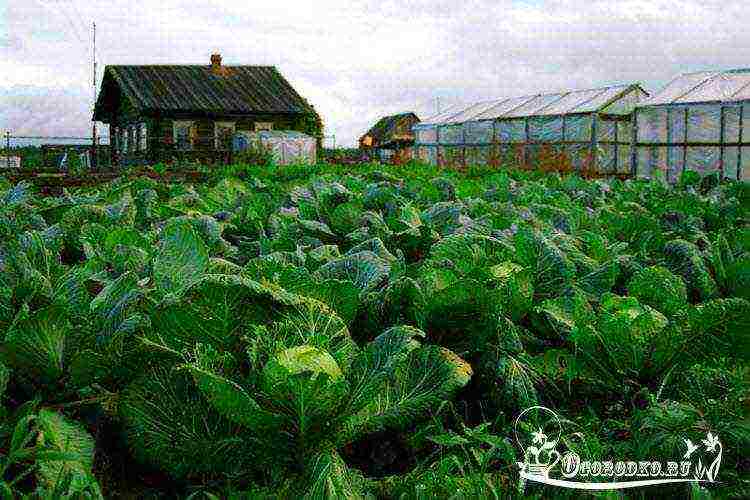
Many summer residents and gardeners know how to grow cabbage in the open field, each has its own secrets and tricks, but the harvest is different. The technology of growing cabbage is not really complicated, you just need to correctly calculate the timing, plant it on time and properly care for it.

The timing of planting cabbage in the ground
There is direct sowing of cabbage in the ground and cultivation through seedlings. Depending on the planting method, the timing of the expected harvest of the vegetable, the climatic zone of cultivation, the time is calculated.
Planting early cabbage in the ground with seedlings is carried out:
- Moscow region, Moscow region, in the Urals from April 25;
- Perm Territory, Bashkortostan, Udmurtia - from May 5-6;
- Voronezh, Saratov regions starts on April 1;
- Southern regions, in the Kuban - from March 20.
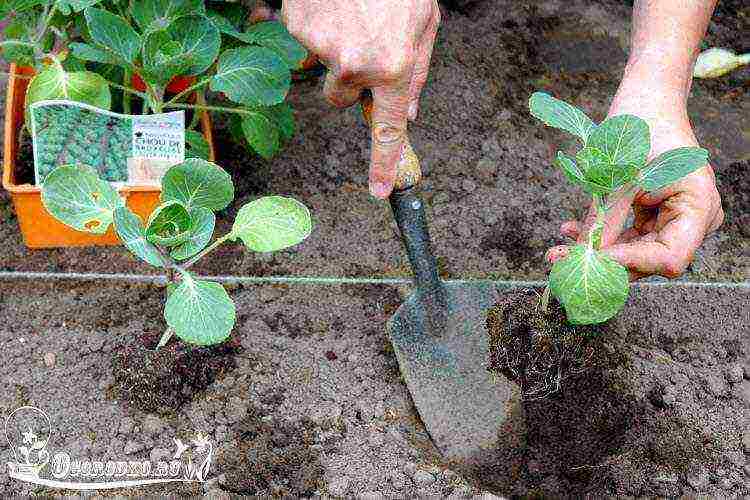 in the photo - planting cabbage seedlings in open ground
in the photo - planting cabbage seedlings in open ground
The age of the seedlings from sowing seed to planting in open ground should be as follows:
- 45 (60) days for obtaining red cabbage, early white cabbage, 35 (45) for mid-season varieties, 30 (35) for late;
- Savoy cabbage 35 (50) days;
- various varieties of cauliflower and Brussels sprouts 44 (50) days;
- seedlings of broccoli 34 (45) days;
- kohlrabi cabbage seedlings are planted at the age of one month.
Sowing cabbage in open ground begins with the arrival of warm days, when the soil warms up a little, a positive positive temperature (8-10 ºС) will be established outside. The indicated dates are advisory in nature, take into account the climatic conditions of the growing region, use the recommendations of the seed manufacturers in order to avoid mistakes when cultivating cabbage.
We recommend:Healthy and strong cabbage seedlings at home! It is not always possible to grow good seedlings at home on the windowsill, what are the reasons? If there are problems, then there are solutions for them! If you follow the correct agricultural techniques, you can avoid common mistakes ... "
How to plant cabbage?
Before planting cabbage seedlings in open ground, prepare the garden bed: loosen, remove weeds that have sprout in the spring. It is advisable to carry out preparatory work on the ridges in the fall: dig up shovels to the depth of the bayonet, apply fertilizers (organic or mineral), lime the soil if necessary. Cabbage loves dense soil, in the fall the earth will settle, in the spring it will only be necessary to loosen the surface with a rake.
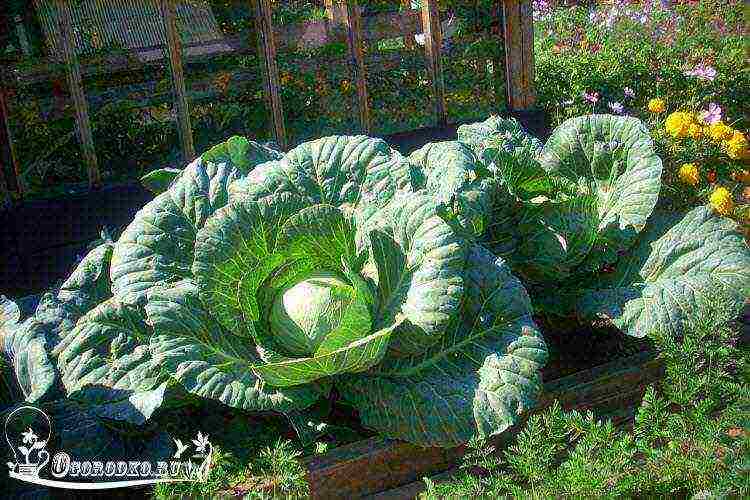 in the photo - growing cabbage in the open field
in the photo - growing cabbage in the open field
Make beds at a distance of 0.4-0.5 meters, dig shallow holes, observing a gap of 35-40 centimeters. Spill the prepared grooves well with water. At this stage, fertilizers are poured into the hole, if the soil is poor, nothing was added in the fall (1 tablespoon wood ash, a teaspoon of superphosphate, a handful of humus). Cabbage seedlings are planted together with a lump of earth, buried in the hole along the lower leaves, covered with dry earth from above, compacted, watered.
Planting cabbage in the ground with seeds for plastic bottles is carried out on the ridges of any length, an intermediate distance between crops is left 0.3-0.4 meters. For convenience, the holes are made with an ordinary glass bottle, a shallow hole is turned with the bottom in the required place by light pressure. 3-4 seeds are placed at the bottom of the resulting groove, covered with a tablespoon of humus (fertile soil), without compaction.
Experienced gardeners have their own planting secrets; it is advised to put a mixture of baking soda (1/2 pack) and black ground pepper (a teaspoon) in the hole with seed material. The addition will protect the cabbage seed from pests, make the soil favorable for the growth of the vegetable (soda deacidifies the soil). Pour the resulting soda composition in small portions (0.5 teaspoons) along the edges of the hole, surrounding the seeds. The bottom of the bottle is cut off, the landings are closed, pressing a little into the ground.The lid is unscrewed as needed for watering, airing the grown seedlings. The bottle should be removed when the first true leaves appear, while at the same time weak shoots are removed, leaving the strongest healthy plants.
Planting care
For growing early cabbage, seeds (seedlings) are covered with a film cover, spunbond, lutrasil. The harvest will grow earlier and will be protected from returnable spring frosts. It is recommended to sow dill and lettuce in the beds along with cabbage. Protective plants planted nearby will protect the planting from cruciferous fleas and other harmful insects.
When cultivating a delicious vegetable in the beds, remember about timely watering, you need to irrigate well until the soil is completely moistened. There is no exact irrigation schedule; it is necessary to focus on the weather conditions of the growing region. In the first weeks after planting the plants, the soil should be moistened, this will ensure good growth of the root system. Limit irrigation while the head is ripening to prevent cracking. You need to water it in the morning and evening hours with cold water, cabbage loves ice cold water.
For the entire cultivation period, cabbage is spud 2-3 times. Hilling is combined with weeding, loosening. The first rolling is carried out after the seedlings have taken root, the soil around the plant is loosened to a shallow depth, then the earth is well scooped up to the first leaves. Hilling contributes to the growth of additional roots, loosening increases the access of oxygen to the roots for better plant nutrition.
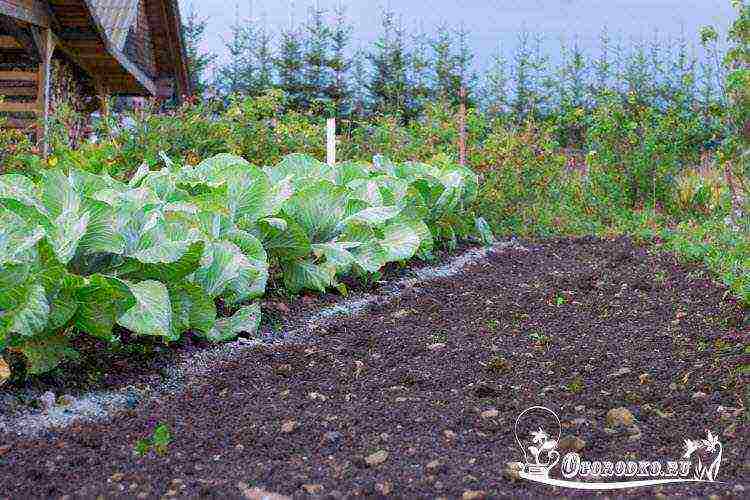 in the photo - feeding with ash, cabbage grown in the open field
in the photo - feeding with ash, cabbage grown in the open field
When growing cabbage, the need for top dressing is determined by the fertility of the soil, the amount of fertilizers applied in the fall. For better growth, it is recommended to nourish the plants with useful microelements 2-3 times, use organic or mineral fertilizing is a personal matter of every gardener.
The first time fertilization is applied 14-15 days after planting in a permanent place, then the cabbage is fed at two-week intervals after the first feeding. Pay attention to the development and growth of the vegetable, if the plants are healthy and strong, there is no need to add nutrients. At the first stages of growth, plantations require fertilizers containing nitrogen in the composition to build up green mass (take 2 teaspoons of urea and potassium fertilizer, add 20 grams of superphosphate, dilute in a bucket of water). Use phosphorus-potassium complexes during the setting of a head of cabbage.
It is not difficult to grow cabbage in a summer cottage, the main thing is to plant it on time, feed it and water it abundantly, then the harvest will grow generous, rich and undoubtedly tasty!
White cabbage is especially popular with Russian gardeners, who are always worried about growing it in the open field and taking proper care of it, and getting high yields.
On our table, white cabbage has long become a must. Many people love it for its high yield and good storage, juicy delicate taste and a whole range of vitamins. In winter, fresh cabbage can be used to make a salad or prepare a filling for pies. When fermented, it becomes a valuable source of vitamins.
Planting dates for white cabbage
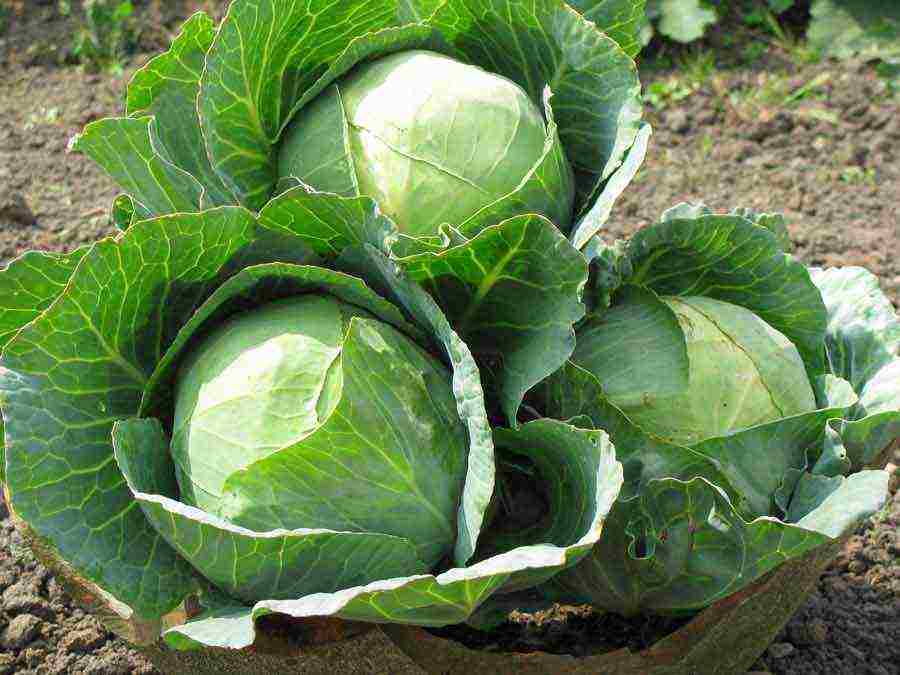
The choice of variety and the timing of sowing white cabbage depend on the intended purpose of the fruit: whether you need tender early cabbage for salads or dense strong heads of cabbage for pickling and winter storage.
White cabbage, which is cultivated by many gardeners, comes in early, mid-season and late varieties. Early varieties are eaten in the summer. Mid-season can be eaten fresh or salted for the winter. Late varieties are intended for long-term winter storage.
The timing of sowing white cabbage for seedlings depends on the variety:
- early: from 1 to 25 March;
- medium: from April 25;
- late: - from April 1 to the third decade of the month.
From the moment of sowing seeds for seedlings to planting seedlings in open ground, it usually takes 45-50 days.
White cabbage can be sown in open ground with seeds. In the middle lane at the beginning of April, seeds of early cabbage are sown in the ground, and in the first decade of May - late. In the southern regions, mid-season varieties are sown from late April to the third decade of May, late-ripening - in 1-2 decades of May.
Selection and preparation of seeds
The choice and purchase of cabbage seeds must be taken responsibly: the future harvest depends on the sowing material.
To increase immunity to fungal diseases, cabbage seeds are recommended to be warmed up in water at a temperature of about 50 ° C for 20 minutes before sowing, and then immersed in cold water for 5 minutes.
Before sowing, the seeds are soaked in cold water and kept for 24 hours. This hardening increases the vigor of the seeds and promotes early germination. In the future, in the open field, such seedlings will withstand frosts down to -7 ° С, and unhardened ones will not withstand even -3 ° С.
Site selection and soil preparation
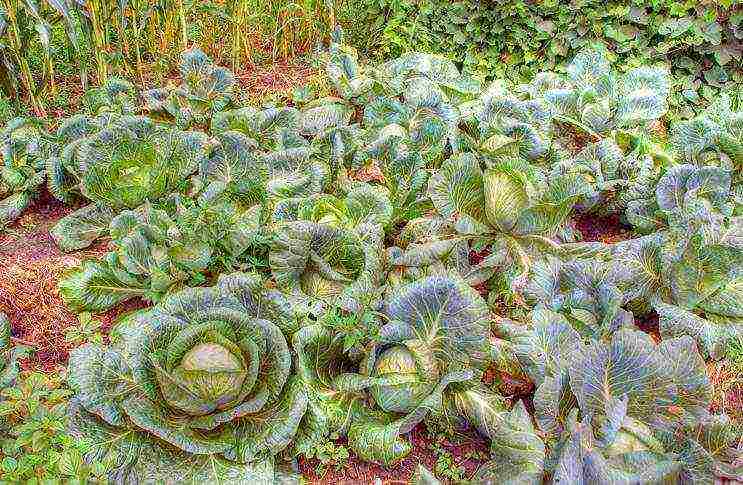
The area for planting cabbage in the open field must be prepared in advance. The sun should illuminate it from morning to evening. Early varieties of cabbage are more suitable for sandy soil and loam, for late and middle varieties, clay soil and loam are optimal.
The acidity of sandy soils should not exceed 6, clay or clay-sandy - 7. Acid soils are not suitable for cultivating cabbage.
It should be borne in mind that it is undesirable to plant cabbage in open ground after tomatoes, beets, radishes, turnips. These crops "suck" nutrients from the soil, and diseases that are dangerous for cabbage can remain in the area after them. For cabbage, it is better to choose those areas where cereals, legumes, cucumbers, and potatoes were previously grown. You cannot plant cabbage on the same bed for more than 2-3 years in a row.
The preparation of the site for growing cabbage should be started in advance, even from the previous planting in autumn. In dry weather, the soil must be dug deep. There is no need to strive to level the surface: the ground with steep irregularities will absorb more moisture during the winter.
In the spring, after the snow melts, they carry out the "moisture closure" - the soil surface is leveled with a rake to prevent too rapid evaporation of water. Weeds that begin to crawl out of the ground must be removed immediately.
Growing technology
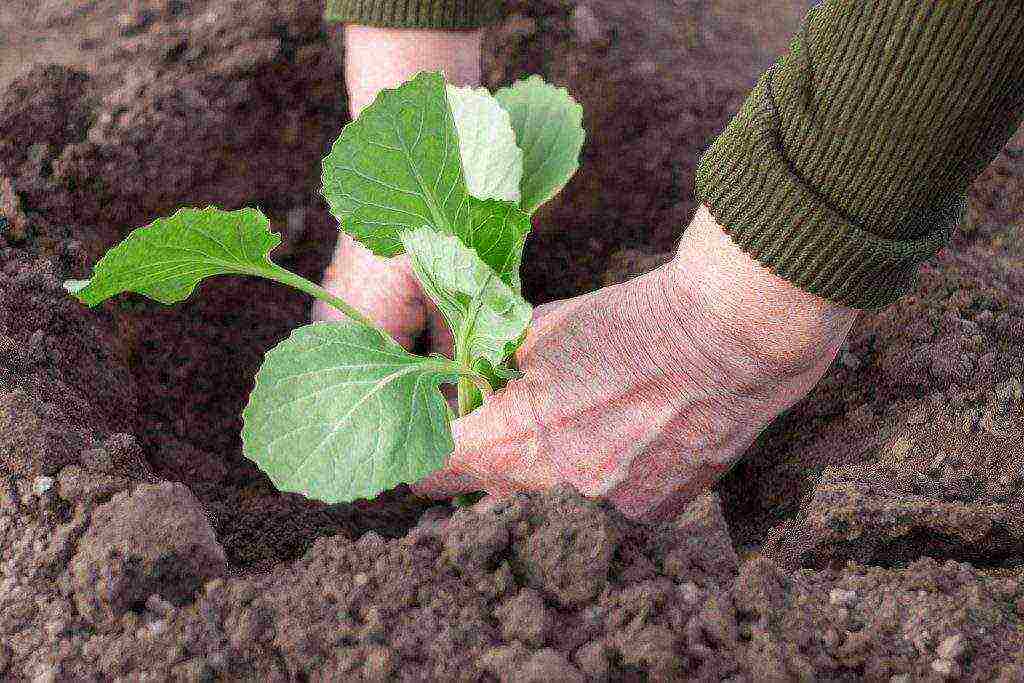
2 weeks before planting in the garden, the seedlings begin to harden in order to prepare them in new conditions in a permanent place. To do this, in a room with seedlings in the first 2 days, open a window for 3-4 hours, having previously protected the seedlings from a draft.
Then, for several days, the seedlings are placed on a loggia or balcony for a couple of hours, covering the shoots with gauze from direct sunlight. After a week, watering is reduced, the seedlings are taken out to the balcony and kept there until planting in the ground.
Seedlings of early white cabbage are planted in a garden bed when it reaches a height of 12-20 cm and 5-7 leaves are formed in the seedlings. Seedlings of mid-season and late cabbage can be planted on a garden bed with a seedling height of 15-20 cm and the formation of 4-6 leaves. Seedlings of early varieties usually reach the required parameters by early May, mid-season and late ones - from late May to mid-June.
To plant white cabbage seedlings in an open area, use the following scheme:
- early and hybrid varieties - 30x40;
- mid-season - 50x60;
- late - 60x70.
Cabbage needs a lot of light and space, so you need to try not to thicken the beds. The holes in the soil should be made a little larger than the root system of seedlings with a peat-distilled glass or an earthen clod.
It is recommended to add to each well:
- a handful of sand;
- a handful of peat;
- 2 handfuls of humus;
- 50 g of wood ash;
- half a teaspoon of nitrophosphate.
The additives are thoroughly mixed and watered abundantly. An earthen lump with the root system of the seedling is lowered directly into the slurry and sprinkled with moist earth, and dry earth is added on top.If the seedlings are too elongated, they are planted so that the first pair of leaves is flush with the surface of the plot.
Without seedlings, seeds are sown immediately on the garden bed quite thickly according to the scheme 10x70 cm to a depth of 1-1.5 cm. It is recommended to water the soil and cover it with spunbond. Only a month later, after the formation of 3-4 true leaves, the cabbage sprouts will get stronger.
Until that time, they will require particularly careful care: regular weeding, pest control. It is recommended to thin out cabbage in the phase of 4-6 true leaves, leaving a distance between seedlings in a row of 40-50 cm.
How to care for plants outdoors?
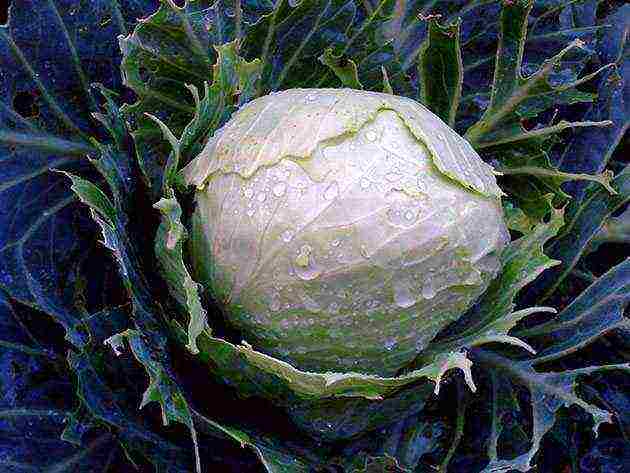
If the weather is sunny after planting the seedlings, the seedlings need to be shaded for a while with non-woven material or newspapers. During the week, the plants are watered every evening from a watering can with a splitter.
After the end of this period, the shelter can be removed if frosts are not expected at night. In the future, for the care of seedlings in the open ground, weeding and loosening of the site, watering, and regular feeding are carried out. The hilling procedure is carried out for the first time 3 weeks after planting the cabbage, and after another 10 days it is repeated.
Watering
Cabbage needs a lot of moisture, so strict adherence to the irrigation regime is required. Evening time is chosen for watering. Between heavy watering on cloudy days, an interval of 5-6 days is enough.
During the hot period, you will have to water the plants every 2-3 days. After watering, the soil on the site must be loosened, while hilling the cabbage. To retain moisture, experienced gardeners recommend a mulching peat layer 5 cm thick, which simultaneously feeds developing plants.
Top dressing
If cabbage is fed during the seedling phase, it should develop quickly and intensively. After planting in the ground, the plants continue to be fed. When the leaves begin to grow, it is best to add a solution of 10 g of ammonium nitrate in 10 liters of water to the soil.
This dose should be sufficient for 5-6 plants. When the formation of the head of cabbage begins, the cabbage is fed a second time from the same calculation, dissolving in 10 liters of water 8 g of potassium sulfate, 5 g of double superphosphate and 4 g of urea.
Treatment against diseases and pests
It is highly undesirable to use pesticides for processing cabbage. To protect young plants from slugs and flea beetles, dusting with ash with the addition of tobacco dust will help.
To destroy aphids and caterpillars, cabbage is sprayed with this infusion: pour 5 liters of water with 2 kg of tomato tops, infuse for 3-4 hours, boil for 3 hours, cool, filter and dilute with water in a ratio of 1: 2. To ensure better "sticking" of the infusion to the leaves, add 20-30 g of grated tar soap to it.
Onion peel infusion is effective against caterpillars and aphids. Fill a liter jar of husks with 2 liters of boiling water, leave the solution to stand for 2 days. Then the resulting infusion is filtered, another 2 liters of water and 1 tablespoon of dishwashing detergent or liquid soap are added to it.
The fight against the scoop, cabbage fly, beetle larvae is carried out with the help of ants. A jar of jam or honey diluted with water is dropped on the site. Black ants, attracted by the sweet, also eat the larvae.
For preventive purposes, sage, rosemary, mint, marigolds, basil, cilantro and other spicy plants are planted in and around the area with cabbage. Butterflies, slugs, flea beetles, aphids will be scared away by the tart aroma, which will at the same time attract their enemies - lacewings, ladybugs, horse-riding beetles.

You can get a generous harvest of vegetables even if you don't have much experience in gardening. You just need to comply with the sowing time and know all the features of growing cabbage in the open field.
The necessary conditions
Cabbage is a very useful and versatile vegetable in preparation: it is fried, stewed, boiled and baked.It is used fresh for preparing salads and cold appetizers, it is included in many first and second courses, it makes mouth-watering stews and excellent fillings for pies. In addition, it should be noted that cabbage is one of the unpretentious garden crops and it is not difficult to provide it with favorable conditions. Still, the successful cultivation of white cabbage depends on compliance with the basic requirements.
The soil under the garden bed is fertilized in the fall by introducing manure, humus or compost for deep digging
The soil for the garden bed is fertilized in the fall by introducing manure, humus or compost for deep digging at the rate of half a bucket per 1 square meter. m area. Mineral fertilizers should be used as carefully as possible, since cabbage tends to accumulate nitrates. Therefore, it is better to abandon them altogether or use them at a lower dosage.
Moisture for cabbage is extremely important and directly affects the formation of the crop. This exactingness is explained simply - the water entering the roots is intensively evaporated by large leaves, as a result of which the plants quickly lose moisture. Therefore, in case of insufficient precipitation, it is necessary to ensure regular watering, and preferably by sprinkling, in order to saturate with moisture not only the soil, but also the air.
If you have sandy soil at your dacha, then for cabbage beds it is better to choose lowlands, places near a reservoir, or plant where it is easier to organize watering.
Video about growing cabbage
Sowing terms and methods
Sowing seeds directly into the soil saves you a lot of hassle
There are two ways to grow cabbage: by sowing seeds in open ground or through seedlings. Each method has its own advantages and disadvantages. So planting seedlings allows you to get earlier yields and provide care for growing plants, which is important when growing in the country, when there is no opportunity to visit the site every day. On the other hand, sowing seeds directly into the ground saves you the hassle of placing containers with seedlings and subsequent transplantation.
When sowing cabbage, it is better to cover the wells immediately on a permanent place with glass jars or transparent plastic bottles with a cut bottom. This will create "greenhouse" conditions for the early germination of seeds and the formation of a rosette. And only when the leaves become cramped under the shelter - they take it off.
Also, when planning to grow your own cabbage, it is worth deciding on the seed, the varietal characteristics of which will determine the sowing time and, accordingly, the expected harvest time.
- Early cabbage is distinguished by tender leaves collected in loose medium-sized heads of cabbage. The crop can be obtained after 90-100 days from germination. The most popular varieties are June, Express, Golden Hectare, Transfer F1. Sowing seeds is carried out from 10 to 25 March.
- Medium cabbage is grown for summer consumption and homemade preserves. Heads of cabbage are ready for harvesting 4-5 months after sowing the seeds. Sorts - Glory 1305, Symphony F1, Table F1 and others. Sowed from late March to April 10.
- Late cabbage with a long ripening period. Its dense, hard heads of cabbage tolerate transportation well and can be stored for a long time, therefore it is most often grown for consumption in the winter. Verified varieties: Stone Head, Kharkovskaya Zimnyaya, Morozko, Arktika F1, Garant F1. Sowing for seedlings or outdoors is recommended from 5 to 20 April.
It is also worth saying that if the seedlings are grown on a windowsill at a room temperature high enough for cabbage, it is very painful to transfer transplantation and adaptation, therefore, two weeks before planting, it must be hardened. You can save yourself from these hassles by sowing seeds in the country in a greenhouse or film greenhouses, where the air is warmed up by the intense spring sun during the day, and at night the temperature drops to minus indices.
Seed Selection Video
Transplanting
There are no exact dates for planting seedlings, but a characteristic feature has been noticed - the younger the outlets, the faster they take root in a new place. Therefore, if the cabbage has already formed 2-3 true leaves, it is quite ready for planting.
Before planting, the seedlings need to be watered generously, especially if they were grown in ordinary containers, and not in peat cups
Having chosen a place for a garden bed, dig up or loosen the soil that has compacted during the winter, level it with a rake and prepare holes, according to the planting scheme:
- for early varieties and hybrids - 30x40 cm;
- cabbage of medium ripening time is planted at a distance of 50x60 cm;
- large heads of cabbage of late varieties will need at least 55x70 cm.
Before planting, the seedlings need to be watered generously, especially if they were grown in ordinary containers, and not in peat cups. The same applies when growing seedlings in a greenhouse, because plants saturated with moisture will more easily tolerate transplanting, and it is easier to extract them from loose soil. Lunochki are also watered with water and, without waiting for it to be completely absorbed, young cabbage rosettes are planted right into this mud. After transplanting, the bushes are again generously watered and mulched with wood chips with the addition of crushed eggshells. Such a shelter will prevent rapid evaporation of moisture and protect the planting from the invasion of slugs, which simply cannot overcome the "prickly" barrier.
Abundant and repeated watering during transplanting will ensure the penetration of cabbage roots into the depths of the soil, where the plant will be able to finish off moisture on its own, without requiring frequent watering.
Video about sowing seedlings
Garden bed care
Further care of cabbage consists in protecting it from numerous pests, preventing diseases, as well as controlling moisture levels and weeding regularly.
Video about caring for planted cabbage
An excellent way to solve problems with protection is the use of modern drugs such as Prestige, which has both insecticidal and fungicidal properties. And in this case, you should not be afraid of using "chemistry", because the action of the drug is limited to two months, after which it completely disintegrates. Therefore, if you strictly follow the instructions and treat cabbage with such a dressing at the seedling stages, you can protect it from cruciferous fleas, cabbage flies, scoops and aphids, and also prevent the development of fungal diseases.
But you can grow kaputa without any "chemistry" at all. Dusting wet cabbage leaves with wood ash and tobacco dust with the addition of ground red pepper powder can become organic measures for insect control. Joint planting of cabbage with garlic, nasturtium, marigolds or black shavings, which scare away pests with their smell, will be a good protection for plantings in the country.
Rate the article:
(4 votes, average: 4 out of 5)


